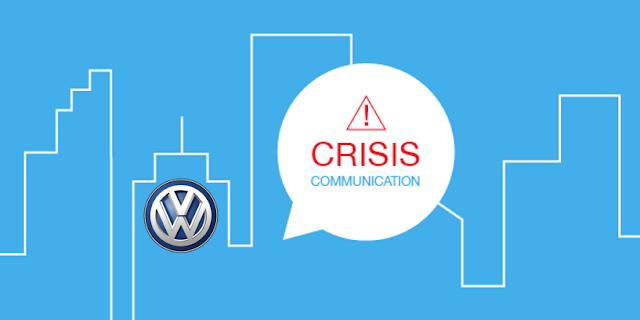CRISIS COMMUNICATION AND REPUTATION MANAGEMENT
Crisis management is a
critical organizational function. Failure can result in serious harm to
stakeholders, losses for an organization, or end its very existence. Few circumstances test
a company’s reputation or competency as severely as a crisis. Whether the
impact is immediate or sustained over months and years, a crisis affects
stakeholders within and outside of a company. Customers cancel orders.
Employees raise questions. Directors are questioned. Shareholders get antsy.
Competitors sense opportunity. Governments and regulators come knocking.
Interest groups smell blood. Lawyers are not far behind.
A crisis is the
ultimate unplanned activity and the ultimate test for managers. In a time of
crisis, conventional management practices are inadequate and ways of responding
usually insufficient. A crisis is
defined here as a significant threat to operations that can have negative consequences
if not handled properly. In crisis management, the threat is the
potential damage a crisis can inflict on an organization, its stakeholders, and
an industry.
A crisis can create three related threats:
- public safety
- financial loss
- reputation loss
Some crises, such as
industrial accidents and product harm, can result in injuries and even loss of
lives. Crises can create financial loss by disrupting operations,
creating a loss of market share/purchase intentions, or spawning lawsuits
related to the crisis.
A crisis reflects
poorly on an organization and will damage a reputation to some degree.
Clearly these three threats are interrelated. Injuries or deaths will
result in financial and reputation loss while reputations have a financial
impact on organizations.
Crisis management is a
process designed to prevent or lessen the damage a crisis can inflict on an
organization and its stakeholders. As a process, crisis management is not
just one thing. Crisis management can be divided into three phases:
- Pre-crisis (prepare)
- Crisis event/response (execute)
- Post-crisis (recover)
1.
Pre-Crisis Phase
Prevention involves seeking to reduce known risks that could
lead to a crisis. This is part of an organization’s risk management
program. Preparation involves creating the crisis management plan,
selecting and training the crisis management team, and conducting exercises to
test the crisis management plan and crisis management team. Organizations are
better able to handle crises when they:
- have a crisis management plan that is updated at least annually
- have a designated crisis management team
- conduct exercises to test the plans and teams at least annually
- pre-draft some crisis messages
The planning and
preparation allow crisis teams to react faster and to make more effective
decisions.
A crisis can take on
many forms, including natural or man-made disasters, environmental spills,
product tampering or recalls, labor disruptions or criminal acts, to name a
few. What makes them a crisis is the fact that they are the focus of intense
media scrutiny.
Although some risks
are beyond a company’s control, others can be foreseen. Research shows that the
vast majority of crises arise when companies fail to identify a potentially
contentious issue at an earlier, more benign, stage, and to develop a plan of
action to manage the issue before the issue manages them.
Creating
a crisis communications plan
The issues audit
becomes the front end of a company’s crisis communications plan, and arguably,
the most important document in the plan. As a complement to a company’s
emergency procedures, the crisis plan should contain detailed communications
response procedures in the event that any of the potential crises identified in
the communications audit, or unforeseen external events, come to pass.
The following is a
checklist of the contents of a good crisis communications plan:
- Names and contact information of the crisis team/ spokespeople. People need to know who holds responsibility for leading the organization through the crisis.
- Crisis triage. Understanding what level of “crisis” you’re facing. Establishing criteria to decide when a minor incident has the potential to become a national crisis can be a challenge.
- ” First response. What information has top priority? How will you initially respond to media?
- Alert/ notification procedures. Who needs to get information, and in what order of priority? PR, by phone, e-mail, social media?
- Situation room. Assess the physical space that will be the nerve center for managing the crisis, including the required hardware and software, staffing, location and layout.
- Stakeholder communications. How do you plan to communicate with customers, shareholders, employees, government and the media?
- Contact lists. Include the “inputs (which media and Internet message boards should be monitored, which opinion leaders should be kept track of, etc.) and “outputs” (which journalists should be contacted, which newspapers and television programs should be approached, which media need to hear your story).
- Template responses. Standardized format, language and protocol for all communications.
- Is this a crisis, or is it simply a continuing business problem coming to the surface?
- Is it confined to a local area, or does it have the potential to become a situation of national or international importance?
- Has someone verified the incident or crisis?
- What are the legal implications?
- What level of resources will be required to manage it?
Access to the crisis
plan is essential. Many companies now maintain both print and electronic
versions for ease of access and remote retrieval.
Testing
the plan
In order to ensure
that the messages contained in the crisis plan are delivered effectively and
with credibility, and that the plan can be carried out, it needs to be tested.
This is where crisis training and simulations come in, as well as media
training.
Crisis training is
best delivered by outside trainers who take participants through crisis theory
and its practical applications to their industry or company. The crisis plan is
reviewed and implemented in a simulated crisis to assess the organization’s
preparedness, and to identify areas that need improvement.
Crisis
Management Team
The common members of the crisis team are public relations,
legal, security, operations, finance, and human resources. However, the
composition will vary based on the nature of the crisis. Training is
needed so that team members can practice making decisions in a crisis situation
while CMP serves only as a rough guide. A key component of crisis team
training is spokesperson training.
2. Crisis Event/Response Phase “Plan for the worst; hope for the best”
Assessing
a crisis
One of the most vital
skills a company can possess is the ability to determine if, when and at what
level of importance a crisis has struck. Despite the best
planning and foresight, organizations inevitably find themselves in a crisis
from time to time. The crisis response is what management does and says after
the crisis hits. Public relations plays a critical role in the crisis
response by helping to develop the messages that are sent to various public. A great deal of research has examined the crisis response.
That research has been divided into two sections:
- The initial crisis response
- Reputation repair and behavioral intentions
Initial
Response
The initial crisis response guidelines focus on three
points:
- be quick
- be accurate
- be consistent
Be quick seems rather
simple, provide a response in the first hour after the crisis occurs.
That puts a great deal of pressure on crisis managers to have a message ready
in a short period of time. When a crisis occurs, people want to know what
happened. Crisis preparation will make it easier for crisis managers to respond
quickly. Communicate with employees. Remember that employees are your
front-line “ambassadors” in a crisis. Be sure they are aware of what the
company is doing to deal with the situation.
Obviously accuracy is
important anytime an organization communicates with public. People want accurate information about what happened and how that event might affect
them. Because of the time pressure in a crisis, there is a risk of
inaccurate information. If mistakes are made, they must be corrected. However,
inaccuracies make an organization look inconsistent. Incorrect statements
must be corrected making an organization appear to be incompetent. The
philosophy of speaking with one voice in a crisis is a way to maintain accuracy.
The crisis team needs
to share information so that different people can still convey a consistent
message. The spokespersons should be briefed on the same information and
the key points the organization is trying to convey in the messages.
Reputation
Repair and Behavioral Intentions
Accommodate means that the response focuses more on helping the
victims than on addressing organizational concerns. The master list
arranges the reputation repair strategies from the least to the most accommodating reputation repair strategies. It should be noted that reputation repair can be used in the crisis response phase, post-crisis phase,
or both. Not all crises need reputation repair efforts. Frequently
the instructing information and expressions of concern are enough to protect
the reputation. When a strong reputation repair effort is required, that
effort will carry over into the post-crisis phase. Or, crisis managers
may feel more comfortable waiting until the post-crisis phase to address
reputation concerns.
3.
Post-Crisis Phase
In the post-crisis
phase, the organization is returning to business as usual. The crisis is
no longer the focal point of management’s attention but still requires some
attention. As mentioned before, reputation repair may be continued or
initiated during this phase. There is important follow-up communication that is
required. First, crisis managers often promise to provide additional
information during the crisis phase. The crisis managers must deliver on
those informational promises or risk losing the trust of public wanting the
information.
Second, the organization needs to release updates on the
recovery process, corrective actions, and/or investigations of the
crisis.
Companies should
consider a broad range of potential communication initiatives to restore trust
and loyalty. Public opinion surveys can track changes in attitudes towards a
company in the weeks and months after reputation-focused programs are launched.
A formal analysis of what was done right, what was done wrong, what could be done better next time and how to improve various elements of crisis preparedness is another must-do activity for any Crisis Communications team.
Sources:
W. T. Coombs, 2012.
Ongoing Crisis Communication
P. A. Argenti, 2009. Corporate
communication
Jonathan Bernstein - The
10 Steps of Crisis Communications
Timothy Coombs - Crisis Management and Communications
David Weiner - Crisis communications:
managing corporate reputation in the court of public
Rick Kelly - What Is Crisis
Communications?
https://www.youtube.com/watch?v=XXiVjjGjIFQ





Wow, this really resonated with me! Your perspective is refreshing and thought-provoking. Thanks for sharing!
ReplyDeleteNinza Host Is platform par, aap crisis situations ke liye proactive plans develop kar sakte hain, jo aapki brand ki credibility aur trust ko banaye rakhne mein help karega.
ReplyDelete